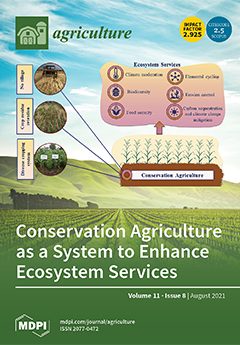Whiteflies,
Bemisia tabaci Gennadius (Aleyrodidae: Hemiptera), are a polyphagous economically destructive pest of several solanaceous crops around the world. Many secondary metabolites are synthesized by different biotrophic and necrotrophic fungi which are capable of inducing systemic resistance in plants against various phytophagous pests. The present laboratory work demonstrated the anti-insect impact of a protein extracted and purified partially from an entomopathogenic fungus (EPF)
Lecanicillium lecanii (Zimmermann) against
B. tabaci. Three different concentrations (i.e., 7.43, 11.15, and 22.31 μg mL
−1) of this protein were bioassayed to assess its effect on the fecundity rate of
B. tabaci on cotton (
Gossypium hirsutum L.) plants. Furthermore, the possible implication of this fungal protein in defense pathways of cotton plants was evaluated by determining the expression profiles of salicylic acid (SA) and jasmonic acid (JA) pathways related to major genes through reverse transcription qPCR (RT-qPCR). According to the results, all protein concentrations exerted a significant (F
3, 252 = 62.51;
p ≤ 0.001) and negative impact on the fecundity rate of
B. tabaci females. At the highest protein concentration (22.31 μg mL
−1), the minimum rate of fecundity (i.e., 2.46 eggs female
−1day
−1) of
B. tabaci was noted on the seventh day, whereas fecundity rates for the other two protein concentrations (i.e., 11.15 and 7.43 μg mL
−1) were, respectively, 3.06 and 3.90 eggs day
−1 female
−1. The maximum rate of fecundity (6.01 eggs female
−1day
−1) was recorded in untreated (control) treatments. In addition, the foliar application of
L. lecanii derived protein significantly upregulated all SA linked genes (OPR3, PPO1 and COI1) and slightly triggered up the JA linked genes (LOX1, UBQ7 and AOS) in the cotton plants. These findings revealed that this
L. lecanii extracted partially purified protein triggered systemic resistance against
B. tabaci in the cotton plants, proposing its putative effectiveness as an innovative biological control technique against
B. tabaci and other phloem-feeding hemipteran pests. Nevertheless, further investigations such as purification and molecular and functional characterization of this
L. lecanii-derived partially purified protein are required.
Full article





